- Many protein-coding genes in bacteria are clustered together in operons which serve as transcriptional units that are coordinately regulated.
- It was Jacob and Monod in 1961 who proposed the operon model for the regulation of transcription.
- The operon model proposes three elements:
- A set of structural genes (i.e. genes encoding the proteins to be regulated);
- An operator site, which is a DNA sequence that regulates transcription of the structural genes.
- A regulator gene which encodes a protein that recognizes the operator sequence.
- Operons are thus clusters of structural genes under the control of a single operator site and regulator gene which ensures that expression of the structural genes is coordinately controlled.
Interesting Science Videos
Trp Operon
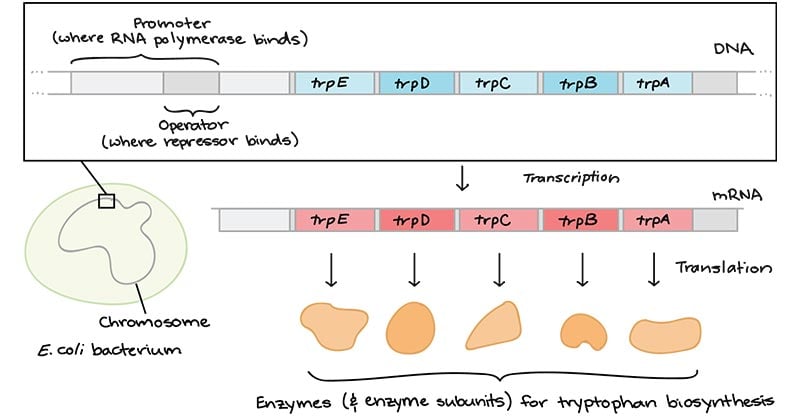
- The tryptophan operon is the regulation of transcription of the gene responsible for biosynthesis of tryptophan.
- The tryptophan (trp) operon contains five structural genes encoding enzymes for tryptophan biosynthesis with an upstream trp promoter (Ptrp) and trp operator sequence (Otrp).
- Structural genes are TrpE, TrpD, TrpC, TrpB and TrpA
- trpE: It enodes the enzyme Anthranilate synthase I
- trpD: It encodes the enzyme Anthranilate synthase II
- trpC: It encodes the enzyme N-5’-Phosphoribosyl anthranilate isomerase and Indole-3-glycerolphosphate synthase
- trpB: It encodes the enzyme tryptophan synthase-B sub unit
- trpA: It encode the enzyme tryptophan synthase-A sub unit
- The trp operator region partly overlaps the trp promoter.
- The operon is regulated such that transcription occurs when tryptophan in the cell is in short supply.
In the Absence of Tryptophan
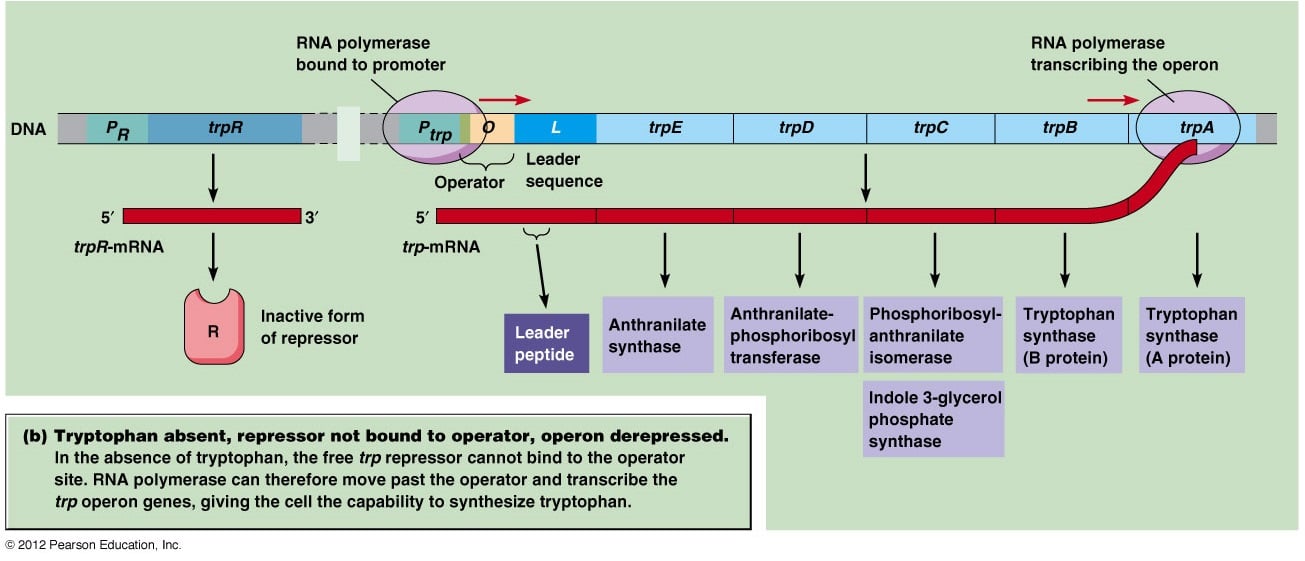
- In the absence of tryptophan, a trp repressor protein encoded by a separate operon, trpR, is synthesized and forms a dimer.
- However, this is inactive and so is unable to bind to the trp operator and the structural genes of the trp operon are transcribed.
In the Presence of Tryptophan
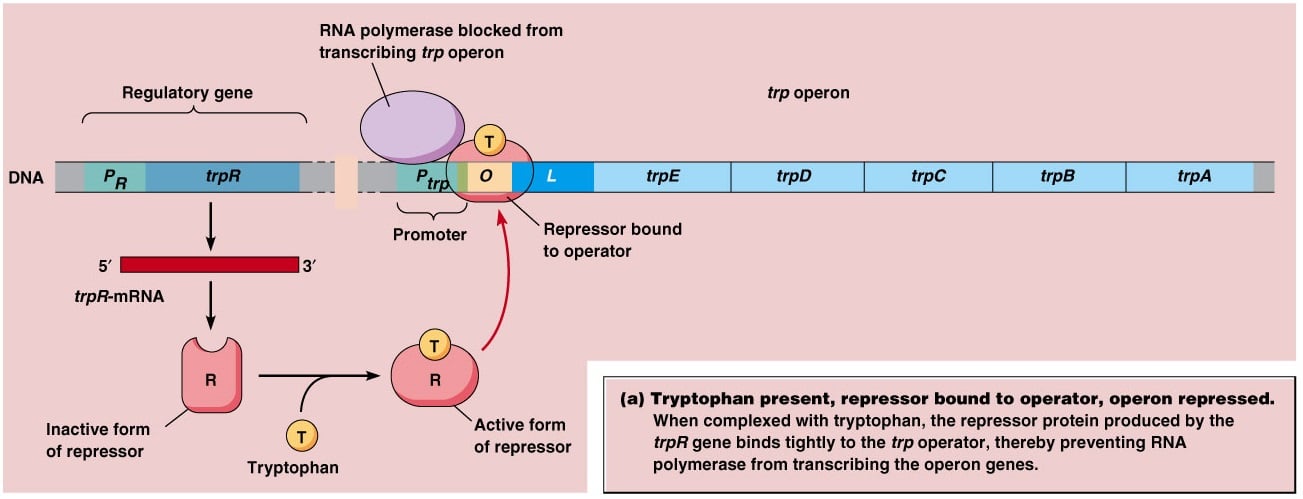
- When tryptophan is present, the enzymes for tryptophan biosynthesis are not needed and so expression of these genes is turned off.
- This is achieved by tryptophan binding to the repressor to activate it so that it now binds to the operator and stops transcription of the structural genes.
- Binding of repressor protein to operator overlaps the promoter, so RNA polymerase cannot bind to the prometer. Hence transcription is halted.
- In this role, tryptophan is said to be a co-repressor. This is negative control, because the bound repressor prevents transcription.
Trp Operon Attenuation
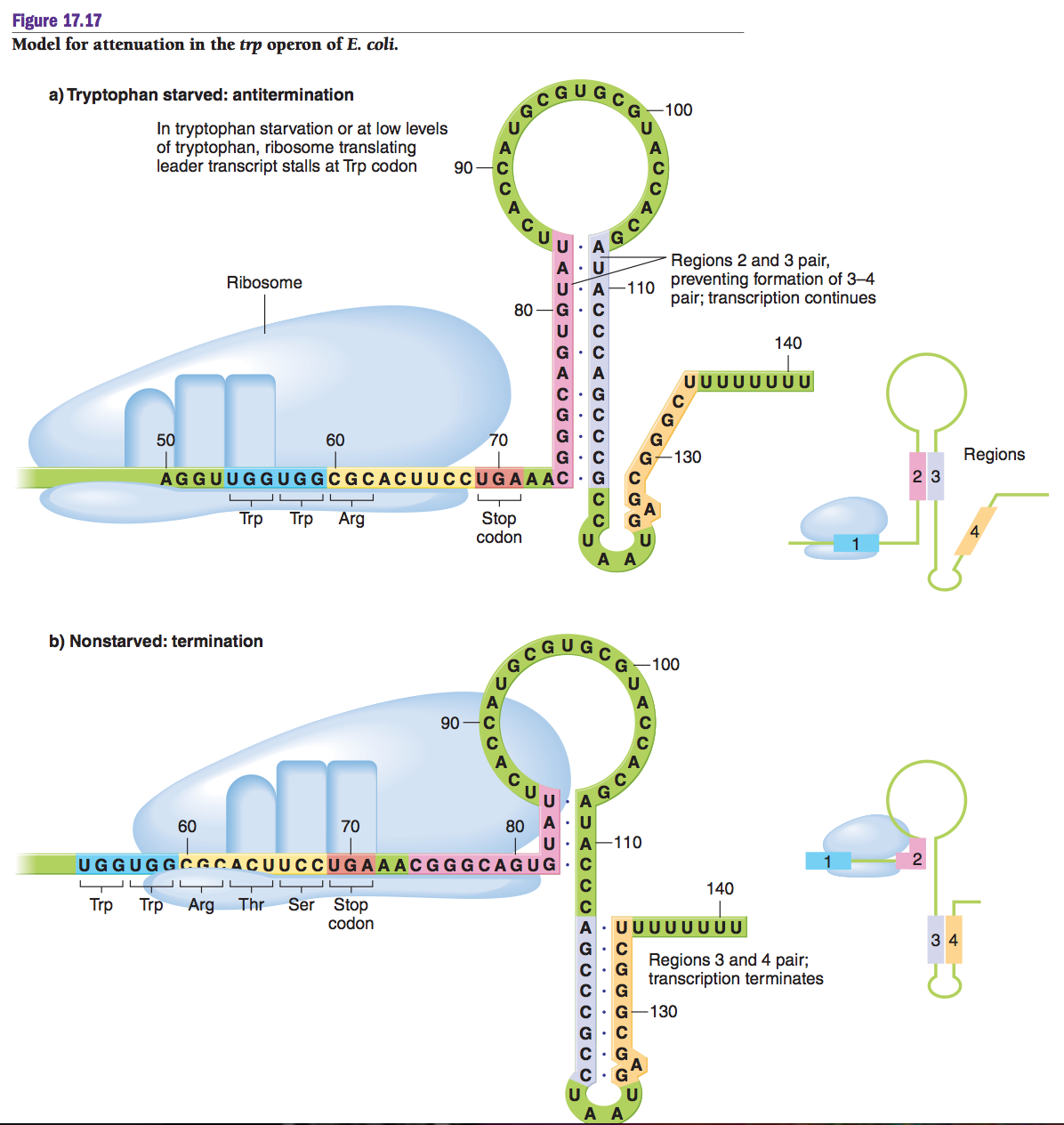
- A second mechanism, called attenuation, is also used to control expression of the trp operon.
- The 5′ end of the polycistronic mRNA transcribed from the trp operon has a leader sequence upstream of the coding region of the trpE structural gene.
- This leader sequence encodes a 14 amino acid leader peptide containing two tryptophan residues.
- The function of the leader sequence is to fine tune expression of the trp operon based on the availability of tryptophan inside the cell.
The leader sequence contains four regions (numbered 1–4) that can form a variety of base paired stem-loop (‘hairpin’) secondary structures.
- The regions are: Region 1, region 2, region 3 and Region 4. Region 3 is complementary to both region 2 and region 4.
- If region 3 and region 4 base pair with each other, they form a loop like structure called attenuator and it function as transcriptional termination. If pairing occur between region 3 and region 2, then no such attenuator form so that transcription continues.
Attenuation depends on the fact that, in bacteria, ribosomes attach to mRNA as it is being synthesized and so translation starts even before transcription of the whole mRNA is complete.
When Trypophan is abundant

- When tryptophan is abundant, ribosomes bind to the trp polycistronic mRNA that is being transcribed and begin to translate the leader sequence.
- Now, the two trp codons for the leader peptide lie within sequence 1, and the translational Stop codon lies between sequence 1 and 2.
- During translation, the ribosomes follow very closely behind the RNA polymerase and synthesize the leader peptide, with translation stopping eventually between sequences 1 and 2.
- At this point, the position of the ribosome prevents sequence 2 from interacting with sequence 3.
- Instead sequence 3 base pairs with sequence 4 to form a 3:4 stem loop which acts as a transcription terminator.
- Therefore, when tryptophan is present, further transcription of the trp operon is prevented.
When Trypophan is scarce

- If, however, tryptophan is in short supply, the ribosome will pause at the two trp codons contained within sequence 1.
- This leaves sequence 2 free to base pair with sequence 3 to form a 2:3 structure (also called the anti-terminator), so the 3:4 structure cannot form and transcription continues to the end of the trp operon.
Hence the availability of tryptophan controls whether transcription of this operon will stop early (attenuation) or continue to synthesize a complete polycistronic mRNA.
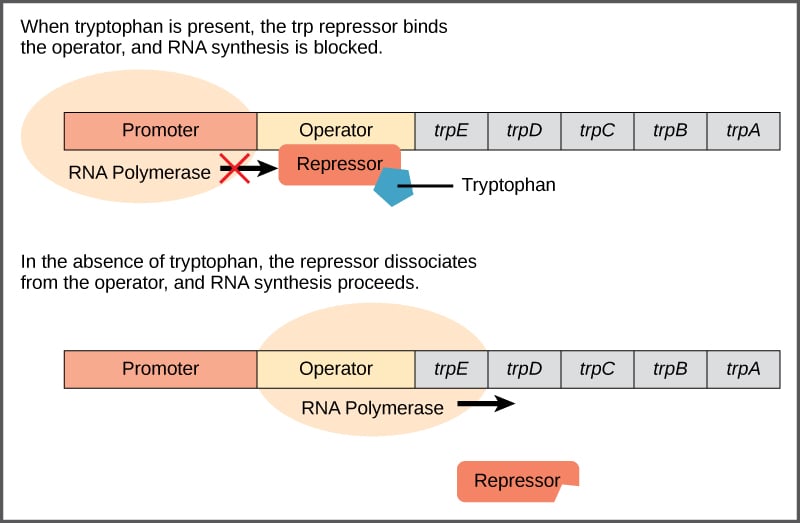
Regulation of Trp Operon
Overall, for the trp operon, repression via the trp repressor determines whether transcription will occur or not and attenuation then fine tunes transcription.
References
- David Hames and Nigel Hooper (2005). Biochemistry and Genetics. Third ed. Taylor & Francis Group: New York.
- Sastry A.S. & Bhat S.K. (2016). Essentials of Medical Microbiology. New Delhi: Jaypee Brothers Medical Publishers.
- https://www.ncbi.nlm.nih.gov/pmc/articles/PMC196965/
- http://www.onlinebiologynotes.com/tryptophan-operon/

Very well explained
Diya
Zoology department
Delhi University
Tryptophan (Trp) Operon
– Many protein-coding genes in bacteria are clustered together in operons which serve as transcriptional units that are coordinately regulated.
•It was Jacob and Monod in 1961 who proposed the operon model for the regulation of transcription.
•The operon model proposes
three elements:
•A set of structural genes (i.e. genes encoding the proteins to be regulated);
•An operator site, which is a DNA sequence that regulates transcription of the structural genes.
•A regulator gene which encodes a protein that recognizes the operator sequence.
• Operons are thus clusters of structural genes under the control of a single operator site and regulator gene which ensures that expression of the structural genes is coordinately controlled.
Trp Operon
• The tryptophan operon is the regulation of transcription of the gene responsible for biosynthesis of tryptophan.
• The tryptophan (trp) operon contains five structural genes encoding enzymes for tryptophan biosynthesis with an upstream trp promoter (Ptrp) and trp operator sequence (Otrp).
• Structural genes are TrpE, TrpD, TrpC, TrpB and TrpA
1. trpE: It enodes the enzyme Anthranilate synthase I
2. trpD: It encodes the enzyme Anthranilate synthase II
3. trpC: It encodes the enzyme N-5’-Phosphoribosyl anthranilate isomerase and Indole-3-glycerolphosphate synthase
4. trpB: It encodes the enzyme tryptophan synthase-B sub unit
5. trpA: It encode the enzyme tryptophan synthase-A sub unit
• The trp operator region partly overlaps the trp promoter.
• The operon is regulated such that transcription occurs when tryptophan in the cell is in short supply.
In the Absence of Tryptophan
• In the absence of tryptophan, a trp repressor protein encoded by a separate operon, trpR, is synthesized and forms a dimer.
• However, this is inactive and so is unable to bind to the trp operator and the structural genes of the trp operon are transcribed.
nice
Hi brother,
Please include Arabinose operon too.
It would be more helpful.
Thanks for this😄